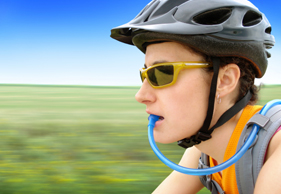When considering what to eat on the bike, there are a few things you need to take into consideration. Firstly, keep in mind that the main aim is to keep replenishing glycogen stores in your muscle throughout your ride. This ultimately is a fine balance between eating enough to prevent hunger, but not overeating to cause stomach problems, nausea or bloating. The easiest way to achieve this is by eating small amounts every 20 to 30 minutes.
Secondly, because cyclists are eating frequently, they are at risk of consuming a large amount of high fat snacks such as cookies, biscuits, chocolate, etc. These are round about 30% fat and may push you over the 20-30% ideal daily intake of fat. Higher fat foods can also delay gastric emptying. Rather opt for complex carbs such as pasta, potato, rice and bread, which offer more carbs and less fat per gram.
Thirdly, you should plan your snacks according to the intensity of your rides. As a general rule, the higher the intensity, the simpler the carbs can be, e.g. gels, energy drinks and fruits. On longer, slower rides, more complex carbs with a higher fat or protein content can be beneficial. A general guideline for a high intensity ride would be to aim for 200 to 300 calories (60g carb) per hour.
Lastly, consider how you will be packaging your snacks. Not only is safety an issue – losing concentration while trying to open packaging, or eating and losing rhythm of breathing and then aspirating – but the easier it is to get the food into your mouth, the more calories you can get in.
Great Snack Ideas
• Dried fruit: It’s easy to package and eat while riding, high in carbs and calorically dense!
• Homemade snack bars/cookies: Easy to pack, relatively less expensive, high energy and carb source, usually containing protein and some fat.
• Commercial power bars: They are pre-packaged, high in energy and calories where exact amount of nutrients are known.
• Energy gels: They are a pre-packaged gel/liquid which can easily be carried and sucked out, rather than chewed. They generally contain simple and complex carbs, and are fat-free. Being a semi-liquid helps speed up stomach emptying and absorption into the blood, boosting energy faster than some solid energy bars.
• Marmite sandwiches: They are cheap compared to commercials gels and bars, offer carbs with a welcome salty taste and texture alternative to continuous sweet snacks.


